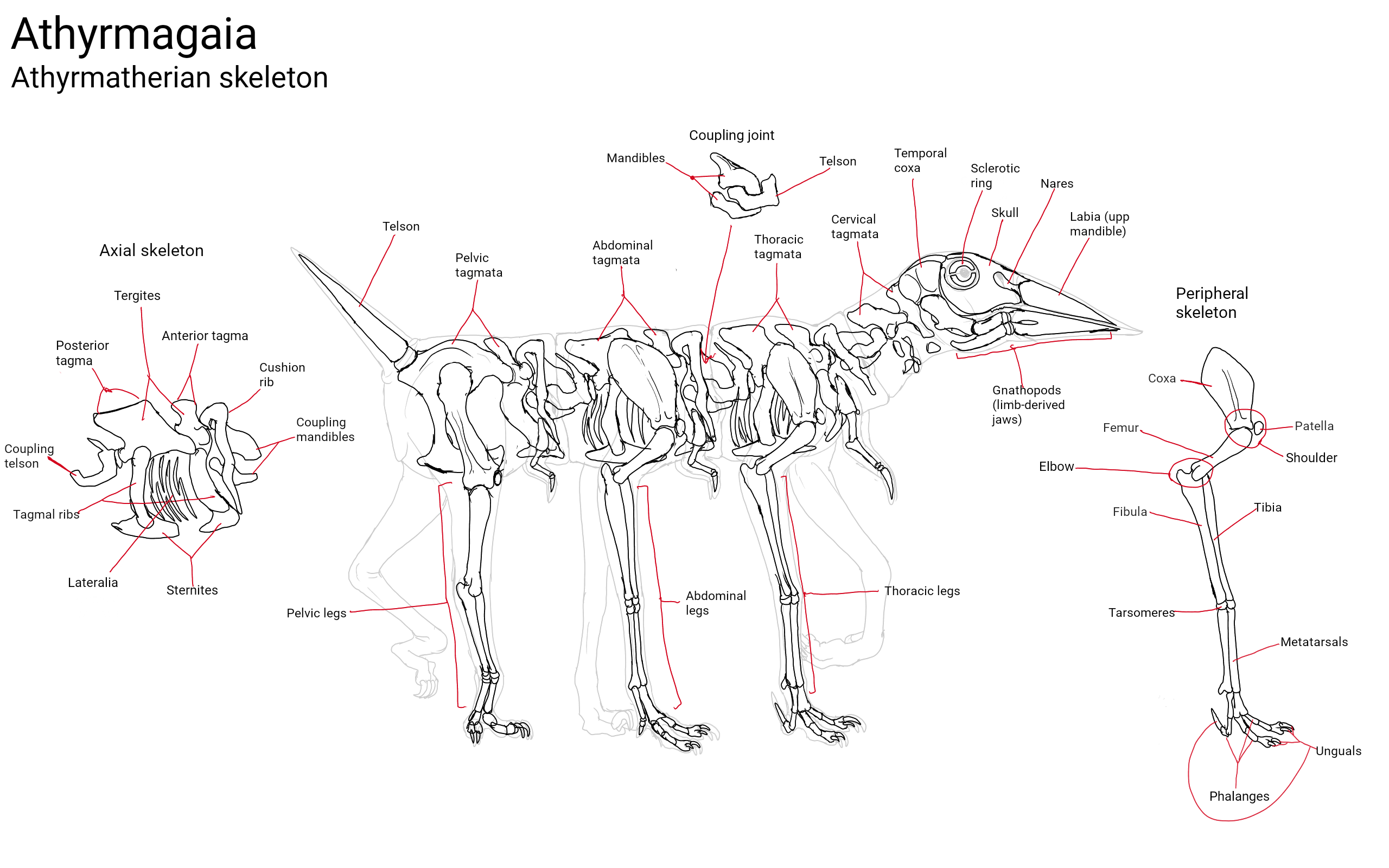HOME | DD
 Batterymaster — Athyrmatherian Anatomy: Skeletal System (OUTDATED)
Batterymaster — Athyrmatherian Anatomy: Skeletal System (OUTDATED)

#alien #xenobiology #speculativeevolution #speculativebiology #speculativezoology #athyrmagaia
Published: 2022-06-20 21:12:51 +0000 UTC; Views: 4253; Favourites: 38; Downloads: 5
Redirect to original
Description
Please look at the new skeleton here !Much like tetrapods, Athyrmatherian s have hydroxyapatite bones composed of calcium phosphate and collagen. The internal structure of these bones is also surprisingly convergent with the condition seen in earth vertebrates, with the long bones of the limbs containing a honeycomb-like matrix of cancellous bone and myeloid tissue (bone marrow). Despite this, the Athyrmatherians are not proper "vertebrates". They are actually members of the phylum Stegospondyla, which are Athyrmagaia's analogues to arthropods, though they are as far removed from their distant insect-like relatives as us humans are from our closest invertebrate relatives, the lancelets.
Rather than a proper spinal column, Athyrmatherians possess an axial skeleton composed of boxy, ring-like bones evolved from internalized exoskeletal tagmata, with the individual zooids latching together through a passive yet sturdy coupling joint system derived from the jaws and tail bones to form a unified "composite skeletal system". Each zooid has four main tagmata: the cranial bone, the anterior tagma, the posterior tagma, and the telson (tail). For the cranial zooid the cranial bone retains its function as a skull, and almost resembles a bird's head. But for the rest of the zooids, the cranial bone is repurposed into a large, arch-shaped bone called a "cushion rib" which functions in conjunction with several additional structures to serve as structural support for the connection surfaces between the zooids. Similarly, the telson only retains its function as a tail in the lower abdominal (aka pelvic) zooid, with the telsons of the other zooids being used as a part of the coupling joint system that connects the zooids together. The tergites of the anterior and posterior tagmata fulfill a function similar to that of vertebra, and surround an equivalent of a central spinal cord, while the sternites function like either a sternum in the thoracic and abdominal tagmata, or a pubis in the pelvic tagmata. Connecting the tergites and sternites together are the tagmal ribs, which evolved from muscles that lined a long-lost hemocoel. In addition to tagmal ribs, many Athyrmatherians also possess additional rib-like structures called lateralia, which are bony or cartilaginous rod-like structures on the sides that are formed from muscles in the body wall. These bones function like our own ribs by protecting the internal organs. In the cranial zooid, the anterior and posterior tagmata are much smaller and unfused, acting as makeshift cervical vertebra called the "cervical tagmata".
Each zooid that comprises the body of an Athyrmatherian has two pairs of limbs; a front pair of "dewlegs" that is smaller and permanently raised off the ground, and a rear pair of larger "locomotor" legs that are typically used for walking. Both limb pairs bear a bone structure that is convergently similar to that of tetrapods, though they bear some fundamental developmental and morphological differences. Rather than developing from fin bones of ancient fish, the long bones of these limbs evolved from ossified muscles and tendons that once anchored to the insides of exoskeletal segments, and the presence of multiple digits on each foot as opposed to the singular tarsus of their more insect-like cousins suggests either the fusion of ancient limbs or a deviation in gene expression that ended up being more beneficial than detrimental. Also as opposed to ancestrally bearing joints that bend at opposite directions, both the dewlegs and locomotor legs bear an arrangement that closest resembles that of a tetrapod forelimb, though the naming conventions of some of the forelimb and hindlimb bones remains the same as that of our own tetrapods for clarity. All four limbs have an upper bone called a coxa, which usually functions like a scapula (aka scapulate) and forms a shoulder. The upper long bone (humerus/femur) and two lower long bones (ulna + radius/fibula + tibia) bend backwards to form an elbow, with the lower limb bones terminating into a wrist or ankle formed from four carpal/tarsal-like bones (carpomeres/tarsomeres). Attaching to the wrist/ankle is an additional set of long bones (metacarpals/metatarsals) that form a hand or foot and terminate into three digits that typically bear claws (one on the third digit, two on the first and second digit). Like the rest of the composite organism, homologous limb structures are modified for different purposes per zooid. For example, the dewlegs of the thoracic, abdominal and pelvic zooids are usually either vestigial or used for mating, but those of the cranial zooid are hypertrophied and used as a pair of independently movable lower jaws called "gnathopods". The pelvic locomotor legs, in contrast to the forelimb-like structure of the thoracic and abdominal pairs, are modified to emulate a structure similar to that of a digitigrade animal from Earth; the coxa is femuroid (femur-shaped) rather than scapulate, and anchors directly into a ball-and-socket joint in the posterior pelvic tagma to function as a thigh rather than a shoulder. As a consequence, the actual femur of the pelvic leg is used as a shin, and the elbow is used as an ankle. On the cranial zooid, the locomotor legs are entirely absent, with the individual bones of these limbs being shrunken and internalized within the animal's neck to act as the organism's inner ear. Some clades even retain the phalanges of this otherwise internalized pair as structural support for external, vaguely mammal-like "ears" called auripods.
EDIT 7/13/2022: Made some major rewrites






















